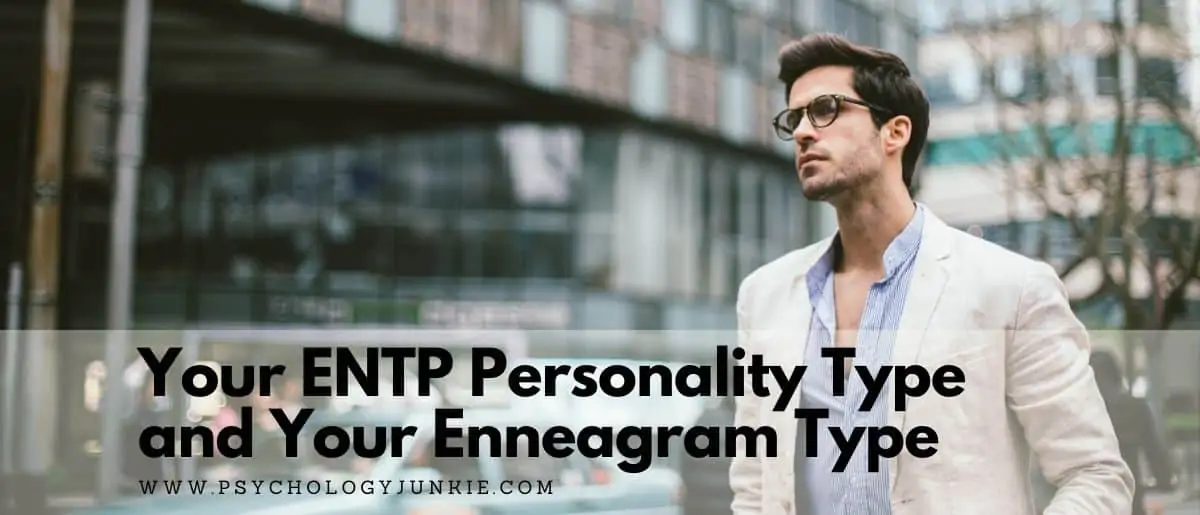Your ENTP Personality Type and Your Enneagram Type
So you’ve taken the Myers-Briggs Type Indicator® and you identify as an ENTP. Now what? Perhaps you read forum threads about ENTPs, books about ENTPs, or talk to other ENTPs. Maybe in your process of self-discovery you think to yourself, “I really don’t relate to a lot of the ENTPs out there….am I really an ENTP?” or perhaps you wonder why there is so much variation from one person of the same type to another of the same type.
This article contains affiliate links to books on Amazon. If you purchase one of these books, I get a small kickback that I can use to pay for hosting and other demands of this site. I only recommend books I love.

Table of contents
- How Enneagram Impacts Your Myers-Briggs® Personality Type
- The Nine Enneatypes and the ENTP
- The ENTP One Enneagram Type
- The ENTP Two Enneagram Type
- The ENTP Three Enneagram Type
- The ENTP Four Enneagram Type
- The ENTP Five Enneagram Type
- The ENTP Six Enneagram Type
- The ENTP Seven Enneagram Type
- The ENTP Eight Enneagram Type
- The ENTP Nine Enneagram Type
Estimated reading time: 15 minutes
How Enneagram Impacts Your Myers-Briggs® Personality Type
There are limitless variations from one person to the next. Life experience, maturity, work – all these things impact how we show ourselves to the world. A Catholic ENTP English teacher is going to look very different from an agnostic ENTP politician.
One of the significant things that can impact you and how you represent your type is your Enneagram type. An Enneatype 2 ENTP is going to appear very different from an Enneatype 7 ENTP.
Today we’re going to explore the nine different types of ENTPs, and some significant differences in how they show up in the world.
Let’s get started!
The Nine Enneatypes and the ENTP
The ENTP One Enneagram Type
Core Fear: Being corrupt, bad, or defective.
Core Desire: Being good and having integrity.
This ENTP will probably not relate to the descriptions of ENTPs as slackers or procrastinators. More than anything, this ENTP wants to make the right choice. The good choice. They brainstorm options and analyze alternatives so that they can be sure what they’re doing is in line with their inner sense of integrity. According to this survey conducted by typology expert Heidi Priebe, One is the rarest Enneatype for ENTPs. The orderly, regimented, strict nature of the One can seem at odds with the more open-minded, explorative nature of the ENTP. ENTPs don’t like to be tied down and they refrain from holding black-and-white judgments. Yet as Ones they often repress a side of themselves that wants to explore shades of grey and alternatives that might lie outside of their ethical boundaries. These ENTPs are harder on themselves than typical ENTPs, more detail-oriented, and more self-disciplined.
The dilemma of the ENTP One is the inner critical voice that punishes them for every minor flaw or lapse in judgment. This voice also points out the weaknesses and failures of others. This critical voice often stems from a childhood where they felt they had to take on a lot of responsibility or even be the “grown-ups” in their homes. They have a lifelong aim to live for a higher purpose – a sense of how the world “should” be or how they “should” be. ENTP Ones can seem more pragmatic and proactive than the typical ENTP. This is because productivity and a level-head are prized by Ones a great deal.
Because Ones are in the Instinct/Body triad of the Enneagram, they tend to experience a lot of anger. Yet unlike Eights, Ones try to repress it. They feel that it’s a “bad” emotion to express. Instead, their anger slips out in critical comments, judgmental remarks, or physical tension.
Unhealthy Ones Can Be: Judgmental, Self-Righteous, Bitter, Overworked, Defensive, and Prone to Black-and-White Thinking. They have a nagging fear that they will never be “good enough.”
Average Ones Can Be: Serious, Driven, Purposeful, Organized, Irritable, Tense, Opinionated, Sarcastic, Hard-Working, Dedicated, Responsible.
Healthy Ones Can Be: Sensible, Grounded, Moderate, Objective, Accepting, Hopeful, Wise, Discerning, Joyful, Humble, Playful.
The ENTP Two Enneagram Type
Core Fear: Of being unloved, worthless, or unwanted.
Basic Desire: To know they are loved.
Another rare Enneatype for the ENTP, Twos are driven to help others and express positive feelings for them. Often labeled “The Helpers,” Twos win people over with their enthusiasm, generosity, and caring nature. ENTPs put a unique spin on the Two Enneatype. They bring the warmth and generosity of the Two, but with a more playful, curious side than is typical. ENTPs are, of course, Thinking types. However, ENTP Twos lean especially heavily on their tertiary Feeling function. Somehow life experiences have made the impression on this ENTP that in order to be valued and worthwhile, they need to be selfless. They need to give and keep giving and never to ask for help in return. They enjoy it when people come to them for guidance, troubleshooting, and advice. They explore options for people and come up with creative, original ways to help them.
In childhood, ENTP Twos were taught to put others’ before themselves. And while this is certainly a good lesson, they usually took it too far. They felt shame when they set boundaries or set their needs ahead of others. They developed a feeling that they had to earn the affection of others through acts of service. Tapping into their thinking side, they tried to fix everything around them in logical ways. They hoped by being responsible, generous members of the family, they would earn their place (and the love of their family).
Because Twos are in the Heart triad of the Enneagram, they tend to experience a lot of issues with shame. They worry that if they stop serving and giving that they will be worthless. On the flipside, they may experience pride because they think that others just wouldn’t be able to make it without them.
Unhealthy Twos Can Be: Desperate, Victim-Minded, Overbearing, People-Pleasing, Manipulative, Over-worked, Angry, Hurt, Exhausted, Insecure, Prideful.
Average Twos Can Be: Selfless, Proud, Complimentary, Supportive, Helpful, Nurturing Flattering, Insecure, Responsible, Well-Intentioned, Possessive.
Healthy Twos Can Be: Generous, Supportive, Expressive, Self-accepting, Joyful, Humble, Imaginative, Creative, Insightful. They prioritize themselves rather than always putting others first.
The ENTP Three Enneagram Type
Core Fear: Of being worthless without success or achievement.
Core Desire: To feel desired, successful, and accepted.
ENTP Threes are driven by the possibility they see everywhere around them. They are typically ambitious, driven, and energetic – anxious to achieve their potential and defy mediocrity in any form. As the primary type in the Feeling triad (2s, 3s, and 4s) they are the most out of touch with their emotional lives. They feel a need to sweep their feelings under the rug in order to be more effective and perform at their best. Their natural intuition propels them down many pathways, but unlike some ENTPs who struggle with slacking and leaving projects unfinished, these ENTPs are more adept at finishing what they start. They are competitive, goal-oriented, and image-conscious. It’s crucial to them to appear at their best and seem knowledgeable about anything that might come their way.
In childhood, ENTP Threes often felt unvalued for who they were. There was a sense that only by doing things successfully or achieving the right status their worth would be validated. Any form of praise lifted their spirits, and they found themselves desperately trying to achieve and strive harder in order to keep that validation coming in. On the outside, these Threes may look somewhat materialistic. They place a high priority on having the right look, the right credentials, or the right house, car, or wardrobe. They worry that without these tokens of success they will be a failure or empty inside. Of course, as they mature through life, they learn the importance of curating integrity rather than material items.
Unhealthy Threes Can Be: Arrogant, Boastful, Depressed, Empty, Angry, Attention-Seeking, Confused, Vain, Deceitful, Overly-Competitive, Burned-Out, Guarded.
Average Threes Can Be: Over-Achievers, Ambitious, Self-Doubting, Self-Promoting, Competitive, Hard-Working, Arrogant, Creative, Visionary, Determined, Restless.
Healthy Threes Can Be: Confident, Creative, Inspiring, Genuine, Self-accepting, Benevolent, Visionary, Imaginative, Insightful, and/or Empathetic. These threes explore their true identity and discover what they actually want rather than what society labels as “success.”
The ENTP Four Enneagram Type
Core Fear: Being insignificant without identity.
Core Desire: To find their significance and unique identity.
Another fairly rare Enneatype for the ENTP, Fours are driven to find their unique place in the world. They often felt misunderstood and out of place in their families growing up and hope to find their identity in a world that seems conformist or callous. ENTP Fours believe that their reasoning is often misunderstood – that they have been forced into a “one-size-fits-all” mode of logic that doesn’t match their natural rebellious, outside-the-box style. This ENTP is deeply in touch with their creative side, finding potential and imaginative possibilities in nearly everything around them. They will typically seem more introverted than most ENTPs, and more in touch with their subjective feelings. This ENTP is deeply individualistic and self-aware and is capable of uncovering surprising truths about humanity and the world itself.
Unhealthy Fours Can Be: Self-destructive, unrealistic, depressed, self-loathing, self-sabotaging, wasteful, apathetic, fatigued, listless, envious, and/or lost in fantasies.
Average Fours Can Be: Imaginative, self-conscious, melancholy, envious, introspective, aesthetically-motivated, self-absorbed, sensitive, empathetic, and/or visionary.
Healthy Fours Can Be: Creative, eloquent, imaginative, insightful, authentic, honest, forgiving, revealing, empathic, accepting, and grateful. They don’t feel a need to be different – they know that there is only one of them and they are good as they are.
The ENTP Five Enneagram Type
Core Fear: Being helpless, incompetent, or overwhelmed.
Core Desire: To be competent and capable.
Observant and curious, ENTP Fives are drawn to complicated ideas and theories. They enjoy brainstorming possibilities and researching to understand the world around them as thoroughly as possible. As members of the Thinking triad, they emphasize thinking over action. The mental world of this ENTP is all-consuming, so they often seem more introverted than the typical ENTP. At home in their minds, they view what’s happening around them from a detached perspective so that they can stay accurate and unbiased. They often see the world around them as unpredictable, especially when they are at average or unhealthy levels of maturity. Because of this, they focus on gathering as much information as possible so that they can feel capable and ready for anything. ENTP Fives fear being overwhelmed by people or influenced by them too strongly. They want to stay as independent and unbiased as possible. Many ENTPs of this Enneatype mistype as INTPs because they are more withdrawn than your typical ENTP. But their dominant-flow state is still into the realm of ideas and possibilities first, rather than logic and detailed analysis.
In childhood, Fives often felt that they weren’t safe in some way. This safety may not have been related to child abuse or anything extreme. They could have felt emotionally overwhelmed by their families or intruded upon. Because of this nagging sensation, they retreated into whatever private space they could find. In the quiet, they wouldn’t have to worry about being overwhelmed by people’s emotions. In private they could absorb books, articles, podcasts, and whatever information they could find. They could daydream, brainstorm, experiment, and explore vast, complex theories.
Unhealthy Fives Can Be: Escapist, eccentric, insomniacs, stuck in analysis-paralysis, afraid, reclusive, secretive, argumentative, under-nourished, fearful, and/or removed from their feelings.
Average Fives Can Be: Insecure, high-strung, cerebral, secretive, skeptical, resentful, imaginative, creative, misunderstood, private, pre-occupied, conceptual, observant, and/or intelligent.
Healthy Fives Can Be: Competent, strong, curious, original, artistic, inventive, original, independent, clear-minded, profound, engaged, grounded, compassionate, perceptive, and/or productive.
The ENTP Six Enneagram Type
Core Fear: To be abandoned and without support
Core Desire: To find security and support
ENTP Sixes are fairly rare, and they often feel quite unsure of their Enneatype – going back and forth between several options because they see bits of themselves in many types. Sixes want security, but they also fight against any feeling of being “stuck” or trapped. They want to trust, but they’re skeptical of authority. They can be likable and warm one moment and suspicious and aggressive the next. ENTP Sixes play devil’s advocate to nearly any idea or theory, immediately spotting loopholes and logical inconsistencies. They’re also insightful about the future, spotting possibilities but also spotting all the ways that they could go wrong. This can make them excel at troubleshooting or creating contingency plans, but it can also make them hesitant and fearful. The Six ENTP is often more cautious than the typical ENTP, although if they are the countertype (Sexual) Six they can seem much more aggressive and risk-oriented. This is because Sexual Sixes fight against their insecurity by fighting for their independence and lashing out at anyone that they fear might try to control them.
Because Sixes are in the Head/Fear triad, they have underlying issues with anxiety. They have difficulty trusting their own minds and they look outside themselves for systems, rules, or authorities that feel unshakable. This is difficult for them, however, because they are also terrified of trusting in anything or anyone that might let them down. Thus, especially at average to unhealthy levels, they feel permanently insecure. Once Sixes reach healthy maturity they learn to trust their own instincts and form lasting bonds and relationships with others.
Unhealthy Sixes Can Be: Plagued by guilt, self-punishing, self-destructive, paranoid, insecure, delusional, obsessed with fears, panicky, helpless, and depressed.
Average Sixes Can Be: Supportive, authority-seeking, authority-questioning, anxious, pessimistic, cautious, impulsive, indecisive, skeptical, cynical, dutiful, and/or hard-working.
Healthy Sixes Can Be: Responsible, committed, practical, well-disciplined, insightful, visionary, friendly, trustworthy, hard-working, grounded, serene, and brave.
The ENTP Seven Enneagram Type
Core Fear: Of being in pain or deprived.
Core Desire: To be happy, satisfied, and have their needs fulfilled.
According to typology expert Heidi Priebe, Sevens are the most common Enneatype for ENTPs! This isn’t exactly surprising, considering Sevens are known for being extroverted, spontaneous, possibility-seeking, and multitalented. ENTP Sevens enjoy jumping from experience to experience to find new data for their intuition to explore. They seek novelty and excitement but have little patience for boredom or routine. One of the strongest assets of the ENTP Seven is their quick and agile mind. They are insatiably curious and often know a little bit about everything there is to know. But they don’t just want to know about things, they want to put those thoughts into action. Thus, they are constantly starting new projects and embarking on new experiences when their curiosity is sparked. Simultaneously, they often struggle to finish what they start because the implementation becomes dull. That said, as Sevens reach healthy, mature stages they learn to cope with boredom and repetition, and thus are able to complete more of what they begin.
In childhood, Sevens often felt a gap between themselves and the mother figure in their life. As a result, they learned to nurture themselves and take care of their own needs. Through toys, games, distractions, and activity they found themselves distracting themselves to numb their pain. Even into adulthood, Sevens look for objects and distractions to help them repress feelings of separation, hurt, and pain. The gap that Sevens feel between themselves and their mother may not have been caused by anything terrible. Another baby might have been born and needed more attention or the mother may have done some minor thing that made the Seven feel less connected than they wanted to be.
Unhealthy Sevens Can Be: Escapists, Impulsive, Hedonistic, Childish, Joyless, Reckless, Scattered, Unstable, Overwhelmed, Paralyzed.
Average Sevens Can Be: Impatient, Imaginative, Self-Centered, Enthusiastic, Excessive, Creative, Distracted, Adventurous, Materialistic, Restless, Skilled at Multi-Tasking.
Healthy Sevens Can Be: Grounded, Bold, Realistic, Charismatic, Visionary, Appreciative, Joyful, Satisfied, Helpful, Profound.
The ENTP Eight Enneagram Type
Core Fear: Being controlled or violated.
Core Desire: To determine their own course in life. To protect themselves.
Independent and intense, ENTP Eights have a powerful, headstrong presence. These types are straight-talkers who don’t want to be managed or told what to do by anyone. As one of the types in the Instict/Body triad, Eights strive to dominate their environment so that they won’t be affected, hurt, or controlled by it. These Eights want to impact their world in a powerful way, often through bringing their innovative ideas to life. They strive to test their ideas out in the real world and they don’t mind taking the initiative to get things done. Because these ENTPs are so independent, they often put their stamp on the world through their entrepreneurial efforts.
ENTP Eights are typically more decisive and commanding than other ENTPs. They view the world as a “dog-eat-dog” environment and they desperately don’t want to be the dog that gets “eaten.” Some Eights seem forceful and formidable, while others, particularly Social Eights, express their aggression in order to help people. Social Eights are more mellow and people-oriented than Sexual or Self-Preservation Eights. But all Eights tend to be impulsive, competitive, and protective.
Unhealthy Eights Can Be: Destructive, Vengeful, High-Tempered, Rejecting, Private, Hardened, Authoritative, Bossy, and/or Confrontational.
Average Eights Can Be: Resourceful, Businesslike, Competitive, Boastful, Willful, Proud, Bad-tempered, Hard-Working, Independent, Visionary, and/or Determined.
Healthy Eights Can Be: Courageous, Heroic, Forgiving, Energetic, Independent, Action-Oriented, Resourceful, Direct, Protective, Generous, Inspiring, Strategic, Decisive, Self-Confident, and/or Authentic.
The ENTP Nine Enneagram Type
Core Fear: Fragmentation, separation, or loss.
Core Desire: To have inner harmony and peace of mind.
Imaginative and open-minded, ENTP Nines strive to live a life that is relaxed and full of exploration and discovery. Typically easy-going, these types search for autonomy and independence without ruffling the feathers of other people. Like Eights and Ones, Nines repress some side of their psyches, particularly their instincts. Rather than giving into their aggression (like the Eight), they repress their ability to assert themselves. They prefer laid-back, stress-free interactions and despise feeling micro-managed, controlled, or criticized. Laughter, imagination, and an unhurried lifestyle make them feel at home. They enjoy exploring possibilities even if those possibilities never come to fruition. They thrive when the world around them feels free, unstructured, and moves at an easy peace.
In childhood, Nines learned early on that the best way to handle turmoil in their environment was to “fade out” or disappear. They learned to dissociate from threatening or traumatic events and make themselves low-maintenance so they wouldn’t bother anyone or make things worse. They felt that if they asserted themselves or became angry they would do nothing but create more problems. So they stayed in the background, repressed their true feelings, their will, and their desires.
The truth is, Nines often build up a great deal of resentment and anger and eventually they will “snap” if they never learn to channel it in healthy ways. Friends and family members may be suddenly shocked when their typically calm, easy-going Nine lashes out unexpectedly once their patience has boiled over.
Unhealthy Nines Can Be: Withdrawn, Unrealistic, Dissociated, Disoriented, Numb, Helpless, Repressed, Neglectful, Lazy, Ineffectual, Depressed, and/or Listless.
Average Nines Can Be: Agreeable, Open-Minded, Amicable, Deflecting, Resigned, Appeasing, Complacent, Disengaged, Compassionate, Dismissive of Pain.
Healthy Nines Can Be: Patient, Level-Headed, Imaginative, Inspiring, Self-Possessed, Serene, Present, Dynamic, Easy-Going, Kind, Patient, Peaceful, Comforting, and/or Spiritual.
What Are Your Thoughts?
Do you relate to any of these descriptions? Which one fits you best? Share your thoughts with other readers in the comments!
Find out more about your personality type in our eBooks, Discovering You: Unlocking the Power of Personality Type, The INFJ – Understanding the Mystic, The INFP – Understanding the Dreamer, and The INTJ – Understanding the Strategist. You can also connect with me via Facebook, Instagram, or Twitter!










YAY NEW MBTI-ENNEAGRAM TYPE DESCRIPTIONS! OwO
I also wanted to clarify one thing. For the parts where you said:
“but unlike some Threes who struggle with slacking and leaving projects unfinished, these Threes are more adept at finishing what they start.” &
“ENTP Eights are typically more decisive and commanding than other Eights.”
I recommend changing it to “more _____ than other ENTPs” because technically all 8s will be at their core, decisive and commanding. And all 3s can be ambitious enough to finish what they start. Take a look at the ExTJ 3s and 8s.
Thanks for clarifying this! I worded it wrong and meant to say ENTP’s where I wrote Threes. Your comment alerted me to that so I’ve fixed it 🙂
Sorry to sound like a nag, but the “ENTP 8s are more decisive and commanding than other 8s” didn’t get corrected to “other ENTPs” yet. Thank you for fixing the 3 though!
When will you be publishing the next MBTI-Enneagram type combos article? It’s been a year and I was really hoping this project wouldn’t be left unfinished because I believe that these, when done for all 16 types, will be really helpful for everyone. Which type are you working on right now and is there a reason why it’s taking so long?
I published the ISFJ one last month I believe and am currently working on the ENFJ one. It takes time because I have lots of other articles to write, along with five kids to take care of at the same time 🙂
Oh! Sorry, I didn’t see it since I typed in “Your ___ and your enneagram type” but I didn’t see any others after the ENTP post since February of last year. Little did I know that the title was worded differently so I missed it. Also I understand, you must be very busy. Cheers
Very interesting! I am an ENTP but I think I am a mix of 4, 7 and 8.. I have a friend who is INTP and another that’s both ENTP/INTP. But we are different but similar at the same time. This clarifies why we aren’t exactly the same. I’m more bold and straightforward than them. And I have a temperament, not afraid of conflict 😂. I’m really good at starting things but not finishing them. I’m also very picky when it comes to details.. like if a waiter forgets something I ordered I don’t hesitate to tell him.
I also see that other ENTP’s have opinions about your article. (I also do that as well, some people get annoyed w me).
Do you know if there is a website where you can do a test to clarify what enneagram you have to be more precise?
All the best!
Lilian